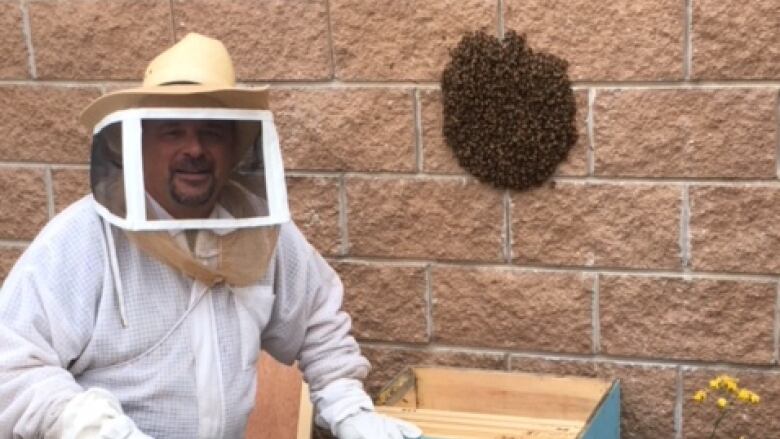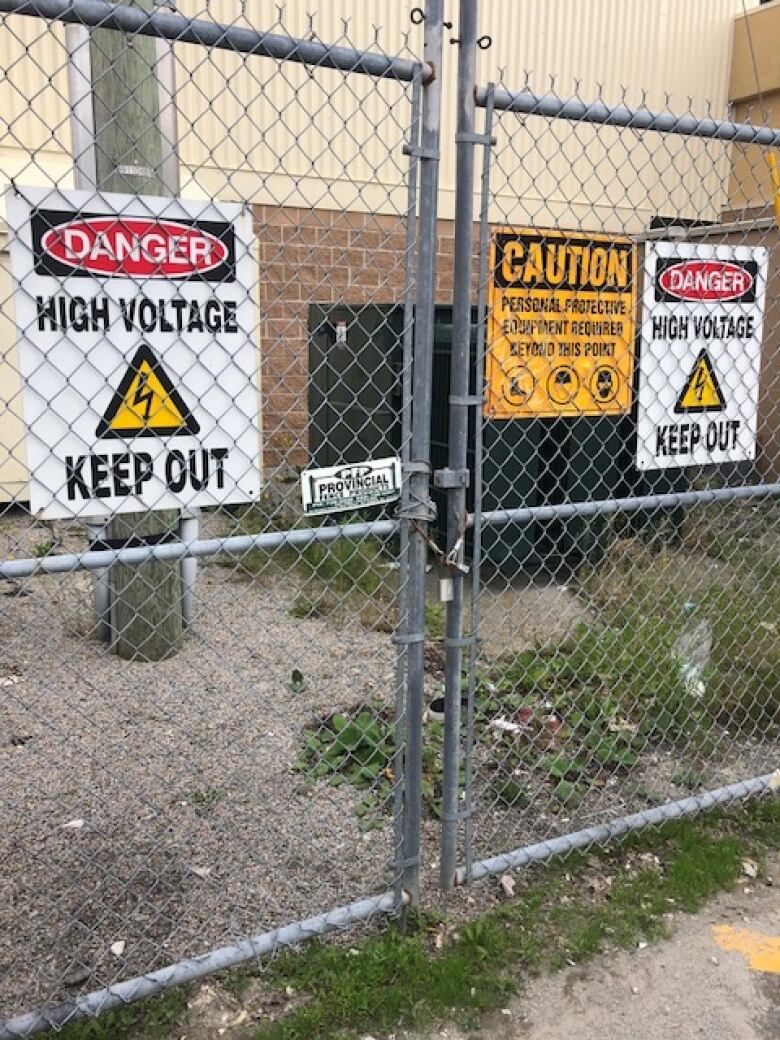Swarm of honeybees rescued after risking the wrong kind of buzz at Avalon Mall
Beekeeper Paul Dinn brought the swarm from a transformer yard to his sanctuary

Construction workers at the Avalon Mall in St. John's got an unexpected buzz when they found a swarm of honeybees in one of the mall's transformer yardsTuesday.
Fortunately for the bees and the nearby workers beekeeper Paul Dinn was ready to spring into action to save them.
When Dinn got a call from the mall's operations manager at about 9 a.m. Wednesdayhe grabbed his equipment for swarm rescues, including an empty hive complete with honeycomb and waxfrom other bees.
"Basically we're bringing a small hive, their home, right to the bees," said Dinn, who runs Adelaide's Honey Bee, Pollinator and Wildflower Reserve with his wife Brenda.
All that homeneeded was a swarm.
What is a swarm, and why do bees do it?
A honeybeeswarm isthe process by which a new honey bee colony is formed.
"Honeybees will gather in a large cluster, and when they do a swarm it's almost like it's snowing and they're very loose and they're going along," Dinn said.
If there's a queen bee in the swarm, the other bees will follow her and when the queen lands the rest of the bees will do the same, with all of the bees bundling up together. The swarm thatlanded in the transformer yard, against the outside wall of the mall, was about the size of a basketball.

A swarm sounds bad, but bees are actually most docile when they're in one because they're looking for a new home and ready to reproduce.
"What they'll do is they'll consume enough honey to last about seven days, so they're actually really full of honey and they're kind of bloated and, a lot of times, are not able to actually bend to sting," he said.
"They're very relaxed, like us after Sunday dinner."
How do you save a bunch of honeybees?
That was the situation Dinn found when he got to the mall, ready to save full-bellied bees in the middle ofboth heavy construction and the shopping centre's ongoing business.
Fortunately, the bees didn't find an electrical yard a very appealing spot for a home and were eager to be relocated.
"I had to just take my hands and gently kind of scoop them, and then lay them in the hive," Dinn said.
It took about 10minutes for Paul to move the swarmed bees from the mall's brick wall into the waiting hive, said Jamie Stroh, the mall's retail manager, and a few hours longer for the remaining stragglers to all make their way inside.
"As per his explanation, their pheromones were still on the brick," she said.
Once the queen was in the hive, Dinn propped the hive up to where the swarm had been andleft its lid open slightly so the other bees would pick up her scent and head inside to find her. He then came back to retrieve the hive at around dusk.
"At that point, all the bees were in and he was able to transport them safely," Stroh said.
Why is it important to rescue honeybees?
Now the bees are settling in at Dinn's property.
"Paul actually sent us a video this morning of the bees in their new home, and they hopefully will enjoy their new rural setting," said Donna Vincent,mallmarketing manager.
Their new home is in a secluded spot of the honeybee reserve, near a pond, with wildflowers and a woods nearby to offer protection from the wind.
"We actually tookthem to one of the less busy areas because they've already been through enough," Dinn said.
"There's not another bee hive within about 30 metres of them."
The call from the mall was the third one fora bee swarm rescue that the sanctuaryhas received this year. Rescuing bees like these isn't only important to Dinn personally, or to other beekeepers. Honeybees are responsible for one-third of food production, he said, and a home like his hives, cared for by a beekeeper, helps them survive long winters and bad weather.
"Ifpeople see a large cluster, they don't need to panic," he said.
"They just need to make a call to us or to a beekeeper in their neighbourhood that they know of,and just let people know that they're there and we'll gladly come over and rescue them."
Newfoundland's honeybees are particularly special one of the healthiest populations in the world, Dinn said.
If people see a large cluster, they don't need to panic. They just need to call us ...- Paul Dinn
"It's only, I believe, three places now in the world Western Australia, the Isle of Man in the Great Britain area, and us that have these healthy, healthy bees," he said.
"We really need to protect them."
Interest in beekeeping in the province is growing, and there are a few things budding apiarists [beekeepers] can do to help keep Newfoundland bees healthy. Don't import bees from other locations, Dinn said, and avoid buying used equipment that could be contaminated with mites or disease.
But for now, these bees are safe and healthy surrounded by food, and far from the site of yesterday's stressful rescue, Dinn said.
"They must have woke up and said 'Ahh, we're in heaven.'"
Corrections
- A prior version of this story has misidentified Paul Dinn as Paul Dunn.Jul 20, 2018 3:32 PM NT












_(720p).jpg)


 OFFICIAL HD MUSIC VIDEO.jpg)
.jpg)



























































































